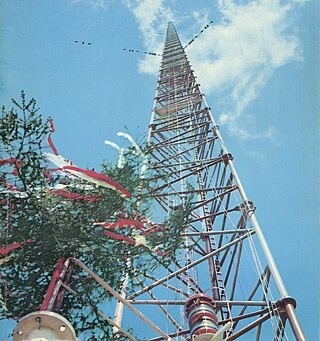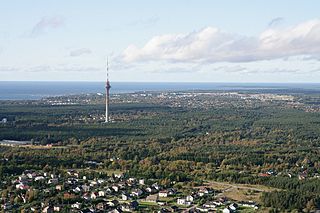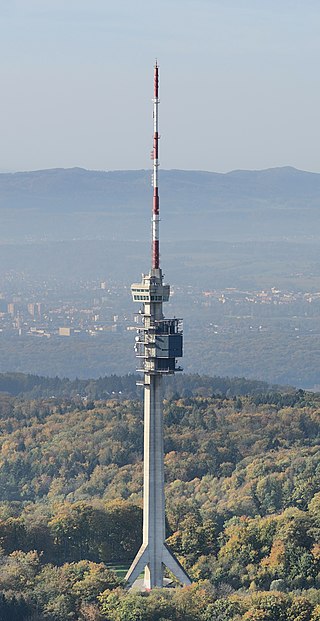
The Warsaw Radio Mast was a radio mast located near Gąbin, Poland, and was the world's tallest structure at 2,120 ft from 1974 until its collapse on 8 August 1991. The mast was designed for extreme height in order to broadcast Soviet propaganda around the world, including to the remotest areas such as Antarctica. As of 2023, it was the third-tallest manmade structure ever built, after the Burj Khalifa tower in the United Arab Emirates in 2009, and Merdeka 118 tower in Malaysia in 2022.

Tallinn TV Tower is a free-standing structure with an observation deck, built to provide better telecommunication services for the 1980 Moscow Summer Olympics regatta event. It is located near the suburb Pirita, six km north-east of the Tallinn city center. With its 313 m (1030.2 ft), the TV tower is the tallest nonbuilding structure in Tallinn. The tower was officially opened on 11 July 1980. The viewing platform at a height of 170 metres was open to the public until 26 November 2007, when it was closed for renovation. The tower began receiving visitors again on 5 April 2012. The building is administered by the public company Levira and is a member of the World Federation of Great Towers.

The Blosenbergturm is a former radio transmission tower built for the German-language radio station DRS at Beromünster in the Canton of Lucerne, Switzerland, in 1937. It radiated first at 529 kHz and later at 531 kHZ, the lowest officially allocated frequency in the European medium-wave band.

A guyed mast is a tall thin vertical structure that depends on guy lines for stability. The mast itself has the compressive strength to support its own weight, but does not have the shear strength to stand unsupported or bear loads. It requires guy lines to stay upright and to resist lateral (shear) forces such as wind loads. Examples include masts on sailing vessels, towers for telecommunications, meteorology, and masts on cranes, power shovels, draglines, and derricks, starting with the simple gin pole.

Swisscom-Sendeturm St. Chrischona is a communications tower built in 1980–1984 near Basel, Switzerland, on the territory of the municipality Bettingen, Basel-Stadt.
The Sender Bielstein is an FM- and TV-broadcasting facility on the 393-metre-high Bielstein mountain in the Forest of Teutoburg, North Rhine-Westphalia, Germany.

The Königs Wusterhausen transmitter was a large transmission facility for longwave, mediumwave and shortwave radio, located near Königs Wusterhausen southeast of Berlin, Germany. Initially built by the telegraph battalion of the German Army, operation began during World War I in 1916. On 22 December 1920, the transmission of a Christmas concert marked the birth of public broadcasting in Germany.

The Orlunda longwave transmitter was a longwave broadcast facility in central Sweden which broadcast Sveriges Radio Programme 1 from 1962 to 1991. The facility is currently in use as a museum.

The Ground Wave Emergency Network (GWEN) was a US Air Force command and control communications system, deployed briefly between 1992 and 1994, intended for use by the United States government to facilitate military communications before, during and after a nuclear war. Specifically, the GWEN network was intended to survive the effects of an electromagnetic pulse from a high-altitude nuclear explosion and ensure that the United States President or their survivors could issue a launch order to Strategic Air Command bombers by radio.

The Winter Hill transmitting station is a broadcasting and telecommunications site on Winter Hill, at the south eastern boundary of the Borough of Chorley, Lancashire, England, and above Bolton. It is owned and operated by Arqiva.

Radio masts and towers are typically tall structures designed to support antennas for telecommunications and broadcasting, including television. There are two main types: guyed and self-supporting structures. They are among the tallest human-made structures. Masts are often named after the broadcasting organizations that originally built them or currently use them.
A broadcast transmitter is an electronic device which radiates radio waves modulated with information content intended to be received by the general public. Examples are a radio broadcasting transmitter which transmits audio (sound) to broadcast radio receivers (radios) owned by the public, or a television transmitter, which transmits moving images (video) to television receivers (televisions). The term often includes the antenna which radiates the radio waves, and the building and facilities associated with the transmitter. A broadcasting station consists of a broadcast transmitter along with the production studio which originates the broadcasts. Broadcast transmitters must be licensed by governments, and are restricted to specific frequencies and power levels. Each transmitter is assigned a unique identifier consisting of a string of letters and numbers called a callsign, which must be used in all broadcasts.

The Rowridge transmitting station is a facility for FM radio and television transmission at Rowridge on the Isle of Wight in southern England.

Microwave transmission is the transmission of information by electromagnetic waves with wavelengths in the microwave frequency range of 300 MHz to 300 GHz of the electromagnetic spectrum. Microwave signals are normally limited to the line of sight, so long-distance transmission using these signals requires a series of repeaters forming a microwave relay network. It is possible to use microwave signals in over-the-horizon communications using tropospheric scatter, but such systems are expensive and generally used only in specialist roles.

Gartow-Höhbeck transmitter is a large facility for FM and TV transmission in Lower Saxony, Germany, situated behalf of the communities of Gartow and Höhbeck.

The Wiederau transmitter is the oldest broadcasting facility in Saxony. It is located near Wiederau, a village which is part of the municipality of Pegau, and is used for medium-wave, FM and Television broadcasting.
Golm transmitter or Sender Golm was a medium wave broadcasting facility on the area of a former Reichsarbeitsdienst officer candidate school at Kuhforter Damm in Golm near Potsdam. It entered service in 1948 as the central broadcast transmitter for Brandenburg state. Until 1979 it used a wooden lattice tower of 98 m (322 ft) height with a horizontal wooden cross on its top as its antenna support. The ends of the beams of this cross were connected with wires. From the centre of each of these horizontal wires, a vertical wire was run down to the antenna tuner which was located in a building under the feet of the tower construction. The antenna of Golm transmitter consisted therefore of 4 T-antennas connected in parallel, forming an omnidirectional antenna with a natural wavelength of 528 m. The transmitter was built from second-hand parts obtained by dismantling a site in Reichenbach, Upper Lusatia. Test transmissions were undertaken on 16 April 1948, and from 1 May 1948 the facility operated on 564 kHz.

The Bungsberg telecommunications tower, also known as the Fernmeldeturm Schönwalde, is a 179-metre-high telecommunications tower situated on the Bungsberg, a hill which is the highest point in the north German state of Schleswig-Holstein.

The Emley Moor transmitting station is a telecommunications and broadcasting facility on Emley Moor, 1 mile (1.6 km) west of the village centre of Emley, in Huddersfield, West Yorkshire, England.
Berlin-Köpenick transmitter was a transmission facility for broadcasting on medium wave, short wave, and VHF in Berlin-Köpenick, Germany, near the suburb of Uhlenhorst, after which it was occasionally named.
















